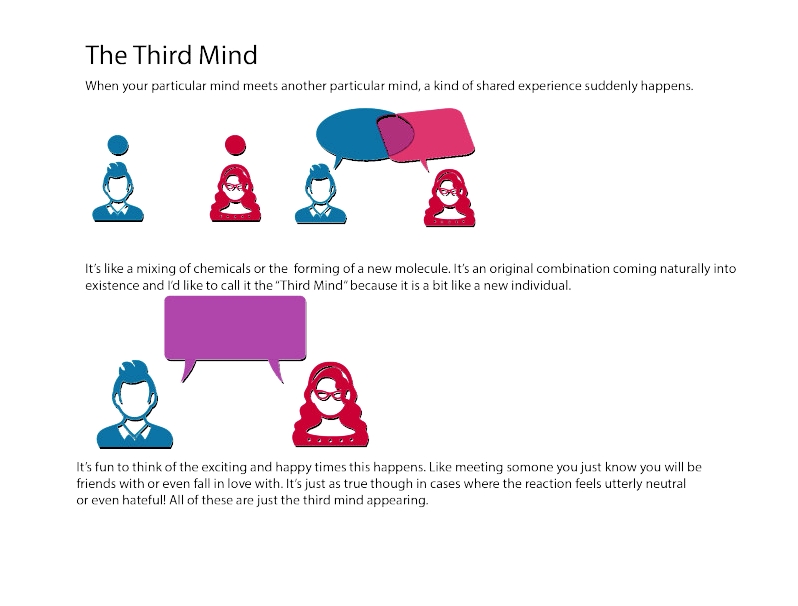The Third Mind
A third mind is created when any two people meet; this mind talks to itself, finds a mood, a temperament, a personality; it is a real self, albeit one created dynamically by relationship.
If excitement and energy are present, this self can do amazing things. As the two participants part company, this mind discorporates but it can be remembered by its participants separately and reincarnated as they reunite. It is a social molecule.
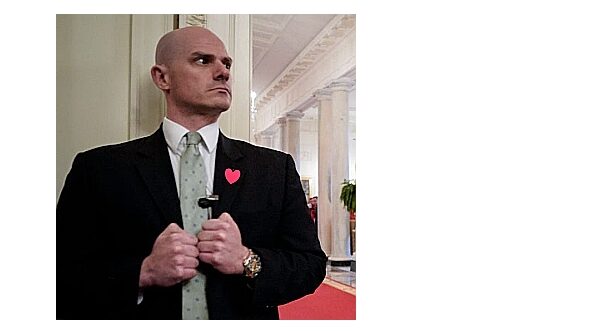
In every Third Mind post, I talk about people becoming social molecules. Two people meet and a sort of third, hybrid self pops into existence. I call it the third mind. It’s generally a wispy, nebulous self at the MOMENT that people meet, as in, introduce themselves. If you think about it there is almost a sort of taste to a first meeting but it’s usually all but drowned out in the psychic noise of social posturing, self-consciousness, and the jumble of talk from all around. Still, it’s there.
The deepening of the third mind between you and another is rather like the creating of a molecule. You are an element, and they are an element, and you both have chemical properties. There will be a chemical reaction when you meet. In most meetings, these reactions are Ho-Hum, almost neutral. With most people, your two elements just look each other up and down and shrug: “Hey.”, “Yup.”
Let’s talk blind dates. When you meet your blind date you know roughly 0.7 seconds in whether this is anything or not. Within half an hour of talk, you know for certain if you ever want to see them again for any reason. Meeting the same person in a different context isn’t the same thing at all. You don’t sprint to such large conclusions when meeting Bob from accounting in the break room for example.
In an online dating context:
As we approach the date we are informed only with expectations based on research data about this new person, the mental dossier we’ve gleaned from their profile and pictures, and texts. Almost everything we feel toward them is emotional doodling or embroidery around this data cluster. It is a hypothesis based on hearsay, advertising, imagination, and self-image. This first impression is bound to the context of the meeting. Two critical variables come into play: The SET and SETTING. The Set is your expectations. It is the emotional baggage or mental clarity you carry into the meeting. The SET is what we think we are doing here and what it potentially means. The Setting is where you meet, but not the street address. It is this place of meeting, but mainly the aesthetics and atmosphere, the mood, and the feeling. We bring our data report into the atmosphere of this bar, or waiting room, or street corner and wait for love as if in a duck blind.
I’m intrigued by this instant knowing. What the hell is it exactly that we instantly know? In that specific moment where you know: “Absolutely not!” as opposed to “Maybe”? It’s mysterious. Little things that don’t feel right about them may come to mind but I think those are more often like rationalizations than real answers. The closest I can get to explaining this interpersonal “dead air” lack of connection is like this: “Sorry, you are experiencing network connectivity problems, try resetting your modem.”
No Connection. True, but no connection to what? Do we have a molecular binding site for romance? A lock and the wrong key? Honestly, it feels to me like everyone has an invisible elephant loyally plodding after them. When you meet, chemistry is how well your invisible elephants get along.
The significance of our mental SET (our expectations) on a blind date is almost literally cosmic: “I might have kids with you”, “I’m seeking my true love”. The overwrought significance of dating gets in the way of dating. You can be completely sensible and have all your ridiculous big expectations, pseudo-expectations, and even ghostly shadow expectations locked away in a big trunk that says “Oh, shut up” on the outside but when you see your date, you can’t unknow the underlying reasons why you are there. Then, 0.7 seconds later you might for example know that something kind of fun and sexual could happen but it wouldn’t be worth the awkwardness of extracting yourself later. Or, that a possible friendship could grow in this soil; OR that we could save ourselves a lot of time and energy by saying goodnight right now.
The issue of rightness is so important to everyone that’s it’s as if an inner representative of your DESTINY steps forward like a humorless secret service agent to pat down your date and gives you the tiniest head shake, no.
Meanwhile, across the table, your date’s secret service agent looks hard at you before giving the same little shake. OK, we’re done here…except for two hours of polite talk entropically cooling toward an awkward goodnight.
“We will see that the 3 pounds of bees in a honeybee swarm, just like the 3 pounds of neurons in a human brain, achieve their collective wisdom by organizing themselves in such a way that even though each individual has limited information and limited intelligence, the group as a whole makes first-rate collective.”
– Thomas Seeley, Honeybee Democracy
Every mind is a composite of disparate elements working cooperatively. Every mind has a “flavor” arising from that diverse cooperation. That flavor is personality and even if we have a thousand things in common with someone else, our personality is absolutely distinct. When you’ve lost somebody and are grieving, you can’t make it better by finding someone like them, no matter how close the likeness. That one-of-a-kind self has vanished, leaving a unique void behind them.
The third mind idea is that 1 unique self plus 1 unique self equals 3 unique selves. There is you and them and us, the “flavor” of that combination.
These are the 6 love styles as understood by current psychology.
- Eros – Classic idealized romantic love.
- Ludus – Multiple love interests with an emphasis on controlling behavior. Lying, cheating and deception are common among people who experience love as Ludus.
- Storge – Love based on Storge takes time, it requires genuine liking and trust of a partner; friendship leading to romance.
- Agape – The powerful desire to want to take care of a partner—a parental or nurturing type of love.
- Mania – Unstable, impulsive and needy. They fall in love quickly, but their love tends to consume them and burn out before it can mature.
- Pragma – Based on common sense, reason and careful consideration. Practical concerns (and safety) underlie this type of love.
The order isn’t important.
When first exposed to these I thought they were awesome, they really help to make sense of behaviors that usually remain undefined. For example as someone who in the past often matched the Storge description, deep feelings arose for me out of solid liking and trust and not until. Being approached by a partner in full Eros mode would thrill me with their interest and passion. That same passion often overwhelmed me with its speed and intensity, making me hesitate in a “deer in the headlights” way that, in turn, made them feel uncertain. The ability to recognize the love style that is approaching makes it possible to anticipate how things are unfolding and respond mindfully.
When people encounter this taxonomy of loving, they often relate to it as a “personality type” tool where they are to pick themselves out of the list. Can you guess what they pick? Most people (according to themselves,) are Eros types. In second place comes Agape with nobody in a close 3rd. The idealized romantic Eros style is what you’d want to be out of this list. It sounds like true love expressed in the healthy, normal, successful way…that mostly occurs in movies. Agape is the popular second choice because so many people feel like they are the more generous, giving one in the relationship and possibly the unfairly unappreciated one. Obviously, most people are wrong about these choices and just trying to feel good about themselves. Ludus, Storge, Mania, and Pragma are the “Not so fantastic four” in this lineup. Storge is the most acceptable of this group because it’s kind of relatable and it doesn’t seem wrong on the face of it, just not very romantic. Pragma next because it’s that, Mania or Ludus. Pragma feels like the opposite of romantic love, practical and transactional. It’s like going into business as a couple. To choose Pragma as your “type” seems like admitting it didn’t go well for you, and here’s how you compromised and settled. Finally, in a popularity showdown between Mania and Ludus, Mania wins because people would rather be messed up than evil. Continue reading
William James was an American philosopher and psychologist, and the first educator to offer a psychology course in the United States. James was a leading thinker of the late nineteenth 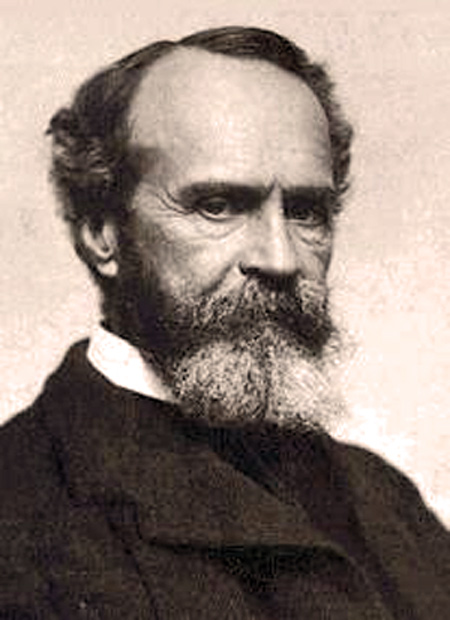 century, one of the most influential U.S. philosophers, and has been labeled the “Father of American psychology”. Among his most influential books are The Principles of Psychology, which was a groundbreaking text in the field; Essays in Radical Empiricism, an important text in philosophy; and The Varieties of Religious Experience. He coined the phrase “stream of consciousness” to describe the experience of the mind. He made an enormous contribution to understanding human behavior and to making psychological practice more pragmatic and empirically based. If there were “Baseball cards” for daring, dedicated and original thinkers, he would be Lou Gehrig. The linked article is a fun overview of his life and work. The Thinker Who Believed in Doing.
century, one of the most influential U.S. philosophers, and has been labeled the “Father of American psychology”. Among his most influential books are The Principles of Psychology, which was a groundbreaking text in the field; Essays in Radical Empiricism, an important text in philosophy; and The Varieties of Religious Experience. He coined the phrase “stream of consciousness” to describe the experience of the mind. He made an enormous contribution to understanding human behavior and to making psychological practice more pragmatic and empirically based. If there were “Baseball cards” for daring, dedicated and original thinkers, he would be Lou Gehrig. The linked article is a fun overview of his life and work. The Thinker Who Believed in Doing.
His theory of Self proposed that there are 4 distinct parts:
“The Constituents of the Self may be divided into two classes, those which make up respectively (a) The material Self; (b) The social Self; (c) The spiritual Self; and (d) The pure Ego.”
My focus here is his model of the Social Self which resembles my model of The Third Mind. The following is edited for relevance from his The Principles of Psychology:
“…Properly speaking, a man has as many social selves as there are individuals who recognize him and carry an image of him in their mind. To wound any one of these his images is to wound him. But as the individuals who carry the images fall naturally into classes, we may practically say that he has as many different social selves as there are distinct groups of persons about whose opinion he cares. He generally shows a different side of himself to each of these different groups. Many a youth who is demure enough before his parents and teachers, swears and swaggers like a pirate among his ‘tough’ young friends. We do not show ourselves to our children as to our club-companions, to our customers as to the laborers we employ, to our own masters and employers as to our intimate friends. From this there results what practically is a division of the man into several selves; and this may be a discordant splitting, as where one is afraid to let one set of his acquaintances know him as he is elsewhere; or it may be a perfectly harmonious division of labor, as where one tender to his children is stern to the soldiers or prisoners under his command.
The most peculiar social self which one is apt to have is in the mind of the person one is in love with. The good or bad fortunes of this self cause the most intense elation and dejection …unreasonable enough as measured by every other standard than that of the organic feeling of the individual. To his own consciousness he is not, so long as this particular social self fails to get recognition, and when it is recognized his contentment passes all bounds.”
Or: Why it’s sometimes OK to hate your neighbor.
The apparent flatness and hard edges of the world we see masks a strange, fluid, flickering dimension between humans. There is no accurate measurement of this dimension except perhaps for our ability to imagine it. Since it isn’t our nature to imagine things this way it takes a little effort.
Please imagine an odd idea; imagine that:
Interaction is embodiment
Imagine that people who engage in any way become a corporate organism for that period. These virtual organisms can flash into existence and straight out again with a speed like subatomic particles in a cloud chamber.
Begin: “Hey, is the Courthouse this way?” “Yeah, just a couple more blocks!” And we’re done. Imagine that exchange as a very short lived individual, existing like a burst of flame.
But two other beings might meet up and eventually celebrate 70 years of marriage, and they were a sort of organism too. In marriage we have some beliefs about this corporate organism that run very deep. “One flesh”. It’s a pretty weird sounding idea to sanctify but it’s honored by religious people and atheists alike. Completely secular people get married with every intention of honoring a mystical contract that defines them as a dual entity. That’s because this idea is deeper than science or religion, it’s core human. This composite organism is the couple’s life together… and I mean IT IS the time and energy they share.
Families also have a special status as a kind of group self. When you think of your own family, you can easily feel the very real lines of connection flowing between you like living tissue and often pulling and kinking in uncomfortable ways. We know that we somehow OVERLAP and that this is one of the most important things about us. Our loves and friends and families are a kind of Venn diagram. But the center of the Venn is you. Subjectivity and individual experience define this thing. Continue reading
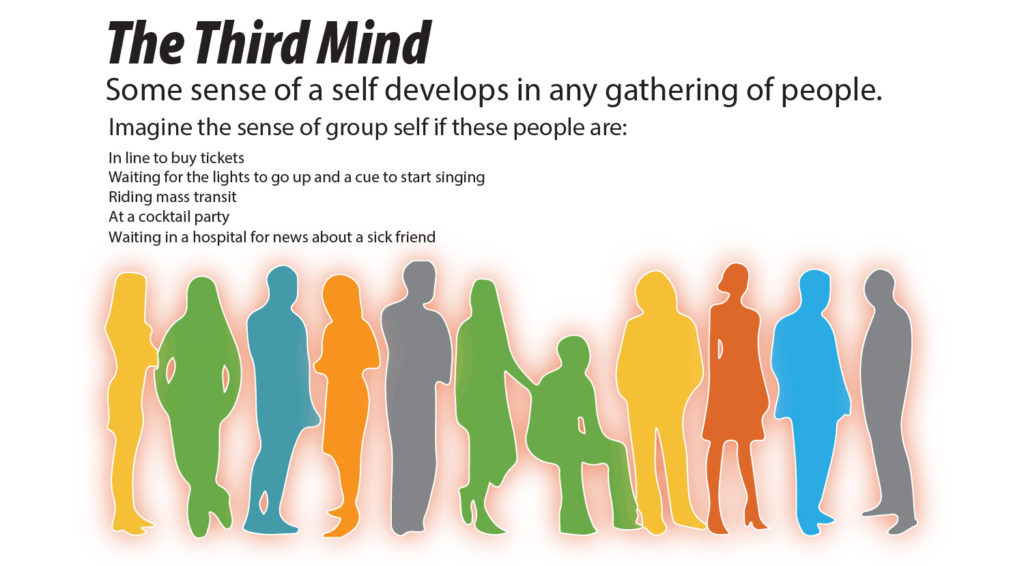
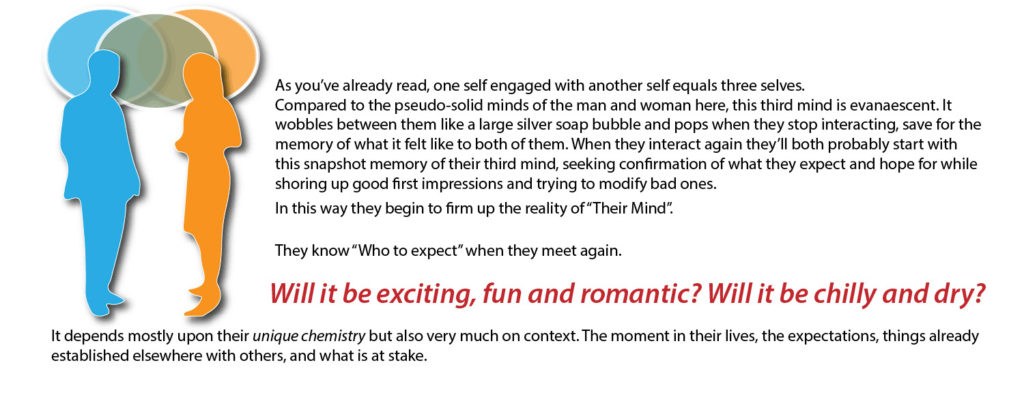
It’s hilarious how much cultural “values”, the dos and don’ts, are exactly like the preferences and peccadilloes of a particular person. These Japanese “no-no”s sound like a description of things that one random person might have very strong feelings about… but in fact, a whole country is ready to be very disappointed in you.
You have your likes and dislikes; your quirks and peccadillos. Put enough of them together in a somebody and you have a personality. You and your love have a relationship, with predominating moods and flavors, things you both love and hate, as recognizable to both of you as each others faces. That is the personality of your relationship and you could almost call it a culture of two. You and your family have a kind of extended self, absolutely made of individuals, but having a corporate nature. Again, moods, styles, activities, and traditions: The personality of your family: The culture of us, ourselves.
Your town and state have cliches and classic types, local foods, music, religions, sports, and jokes. Your area may even have unique social faux pas. You have your classic regional moods, so well defined that Hollywood can set a story in your area as shorthand for the tone of the movie. Your country likewise has these same locally famous traits but pulled from many distant points and due to this diversity, the warmth of these traits is much more diffuse. Americans from Maine might enjoy funny Florida cliches but they don’t evoke the tenderness of good old home-cooked cliches. These taste of home because they are the personality of your region: The self that you are actually a piece of even when parted. If you have been away a long time from the place that is unquestionably your home, odds are that the sight of some hideous local billboard or despised local celebrity might well thrill you and soften your heart. This is you, a tiny particle of that place sensing the correct SELF of belonging and yearning toward it.
Culture is personality flowing bottom-up from a community. It’s the basket holding that composite soul together and in place. It is also the background that makes outsiders visible against it. It’s the recognizable border between us and them. Humans produce culture as naturally as spiders weave webs. The tension force within the culture creates the tone of inclusion tempering exclusion and vice versa. Tension force determines the “temperature” of how cold or warm the welcome is to outsiders.
I don’t associate warm with progressives and cold with conservatives as a political bias, but in this context, conservatism means suspicion, standoffishness or even hostility. Conservatives play the role in the cultural ecosystem of tightening the borders while progressives loosen them. And it isn’t always about a literal border, the border can be about how purely insiders display their cultural loyalty. It can be about disapproving of behaviors becoming less hidebound to cultural authority (often acted out by grumpy old people). Either wing, without the other, is dangerously out of balance. Either wing, deprived of this balancing opposing force, becomes a runaway monster seeking enemies within when it can’t find them without. That’s how desperately important opposition really is. When deprived of it the isolated wing has a panic attack and seeks everywhere for enemies to counter itself. The steady opposition between a healthy left and right results in a cooperative outcome: A tension force that protects the community from the weaknesses of each. This is the community organism as a healthy individual with a well-balanced nature.
Continuing my theme of the hybrid SELF that forms when people interact: The third mind. I’m not trying to create the idea of some kind of mystical entity. The third mind is simply a lens or filter for understanding ourselves.
There is no real “You”.
“Um, I’m right here.”
“Which you are you?”
“Excuse me?”
Friendship:
Every person you know and love has a bond with you like a chemical signature. You think you visit them but you don’t. You visit US. You are a different you with Tom and Petra and Janine. When you visit Janine you think you are seeing her, but you are seeing US.
You know that great way you have fun with her, cooking together and joking around? It isn’t exactly like that with anyone else. That isn’t you and it isn’t her. That’s the third mind. The US. The thing is, your friendship isn’t you and her. It’s what she brings out in you and what you bring out in her. Your friendship is the magic spot where those unique things overlap. This is really reminiscent of the Observer Effect in physics. You can’t study the thing without influencing and effecting it. There is no abstract, pure Janine. You can only know her the way she is when you are looking at her. She can only know you the way you are when she looks at you.
You get together with Janine and your mutual friend Petra. You don’t really know the way Janine is with Petra. You know how Janine is with YOU and Petra. You are standing there with Janine before Petra comes inside. You make a funny literary reference and she laughs and reminds you to keep thinking about that thing you talked about earlier. Why? Because when Petra is part of this molecule the sense of humor is different, maybe earthier, and you’d never really bring up that sort of serious thing for discussion because it would be the wrong kind of discussion. You guys LOVE Petra, you love being together. It’s wonderful, but it’s wonderful in a different way. So you tidied up business with the You and Janine molecule before the well understood transition into the 3 of you molecule.
The personality “You” was evoked in a unique way with one other person and then in another unique way only possible with that exact combination of the three of you. And if you leave, Petra and Janine have a different relationship. If you let yourself ride this idea it’s a hoot because there is no real you, there’s just what can be brought out of you by different people. And since the same is true for them there’s no real anybody anywhere. There are only the unique creations of relationships. In “The Four Loves” C.S. Lewis wrote a beautiful thought on our subject which I have to paraphrase here. Talking about the death of a friend: “If Jim dies I don’t just lose my unique friendship with Jim, I lose the way Jim used to laugh at Robert’s jokes.”
Friendship can be a lovely, lifetime thing in many cases because there is this enjoyable facet of you that you only get be in their company and they evidently have their own version of that joy. One note and another note being played at the same time are not those notes. They are a chord. And the easy, warm cruising of friendships across time is helped by its episodic nature, you don’t ALWAYS have to be that expression of yourself but you can return to it…like an old friend.
You might argue that the real you is who you are when you are alone but you are wrong, and stop being so argumentative!
Even all by yourself, the “You” experience is context-based and evoked by circumstances. It’s actually rather limited. You can’t be that warm, loving guy or the funny guy or the good listening guy. In some ways being alone is sitting with all the things you can’t be. Being in no external relationship reveals a kind of spartan, stripped-down you, but if you are alone for 10 days, I bet you spent time with 4 or 5 different versions of you.
For creative types (and introverts), there can be a special and productive relationship to being alone. A dedicated artist in any field isn’t usually alone because they have built a substantial relationship with the work. The discipline and focus centered on external results provokes, frustrates, and inspires in a way equal to any human company. But it’s still a selective filter that isn’t real in any other situation.
The principles of the third mind are laid out simply above and they don’t change with strangers or those closest to us. What changes is the impact or “side effects”.
Romantic love adds an element that only happens in its domain. Limerence. That dazzling infatuation which when reciprocated turns the third mind into a nearly visible glittering ball between the two people. This is where the third mind transforms into a different entity, almost literally an entity pulling intense emotions and hormones to the surface from the couple. It grows larger and practically seals the lovers inside. Of course, this is the human mating dance. This is the REAL honeymoon, a time of being swept up in something huge and electric and magical. When people look back on this phase, the third mind can seem like anything from a horrible deception to a lost golden age. If it does the job nature intends, a family follows.
Family:
With family relationships, we are playing with forces that help to define us. Mom and Dad are together in a tight pair bond, founded in romantic love. When baby makes three there’s a deep change in the orientation of the parents. Very much a team but a team that doesn’t have a lot of hot sex anymore and a team embarked on a shakedown cruise with a new person. Before the baby is old enough to a political player in the family there’s this period of adjustment to the altered definition of the pair bond. “We are now people who discuss what poop looked like.” This can also be a time where new facets of self come up in Mom and Dad because parenting builds a new floor onto the edifice of YOU. Your way of relating to the kid becomes a bit of new wild card. It’s natural and fine for Mom and Dad to be on somewhat different pages about parenting. But what it does here can be an alteration of the third mind in a way that adds stressors and subtly distances them. It only deepens when the child is a distinct personality, becoming triangulated and heating up any of those parenting issues. At times each feel parent will feel double teamed or manipulated and new kinks in the flow develop. Whatever the couple’s third mind started as it has morphed and tilted. Not necessarily in a terrible way, but forever. There is no going back. And something strange starts to happen here. It can feel like the power of this mind exerts such pressure that you begin to actually possess the characteristics projected onto you. As if the third begins to alter and edit you often in ways that are not pleasant. If people have a common complaint about family it’s probably this: The weird way you can’t help either becoming a certain person around them or putting all your energy into resisting it.
Children grow up with the family mind, a sort of interactive group sense of self: A growth medium made up of ourselves and a variety of subjective, overlapping reactions to us.
Marriage:
God knows there are lovely, happy, and vital marriages out there. And where they exist they probably have a rare relationship where the couple feels a great ongoing enjoyment with what gets brought out of them into the world by the other. This mutual bringing forth: “I love her and I love who I am when I’m with her.”
It’s easy to imagine the reasons things that can become stultifying and even miserable in some marriages. First, unlike friendship, this relationship has no easy come and go. It is your default and almost fulltime existence So it’s more serious from the start but also, people change. Especially as they grow up through their 20s and 30s and 40s. You could hardly help and nor should you, being different after all that. But that means that the unique signature of your personalities as they evoked each other when you married is gone. Perhaps not wholly but substantially. Even without inner change over time, the signature shifts as people reveal their more intransigent sides, as issues become wearisome and people become resigned.
But finally, there’s this: It becomes deadening when you only get to be one version of you year after year. Especially if that version of you is largely defined by a long history of ups and downs, tensions and compromises. Inside ourselves we know we are a 360-degree personality and this arrangement lets you express only a familiar, comforting, reliable constellation of all the possible YOUs for the sake of another person’s security and happiness.
It’s no wonder people struggle. There’s this tremendous investment in a situation that feels gradually less like home because you aren’t really getting to be yourself there or at least the version of you that you’d like to be. And fixing a marriage that feels very stuck is so challenging because even the medium for discussion can only be within the petrified and weary third mind.
There is no one real YOU, there are thousands.
When I’m teaching and a certain magic number of at least 4 students come together I can feel a transformation take place. Before that, I am just ordinary me, talking to individuals one on one. When that critical mass is reached I become a different person, I am the Teacher, rather than just myself. I put on my version of a super-suit. Suddenly I possess a remembering, performing, adapting and extemporizing mind. Suddenly I possess a confident game show host personality of almost infinite confidence and patience. It’s an instant flow state and I enjoy it very much, I’d enjoy being this guy more of the time but he is inaccessible when I am alone.
A corollary effect happens to the class students. A circuit of exchange forms between us and we are like two people pumping one of those old railway handcars together. With enough people participating and with a basic level of openness, of receptivity, there is a tipping point for them as well where they become somehow attuned to a common positive frequency that is attuned to mine and we become a self-maintaining energy flow machine. I give them energy in the form of good teaching and their attention and enthusiasm gives enthusiastic energy back to me that absolutely powers my teaching. We work together to achieve lift-off and the key in both of us is happiness, not long term, but an upbeat feeling, a positive charge.
Shared Energy is the Root of Relationship
If students come to class with the idea that this is all drudgery, beneath them, they pull me down with them. They hold onto my ankles and prevent take off. I can feel the lifeless lack of connection and my job becomes harder. I am doing all the lifting and in the end, I am not happy and energized, I am drained and flat. A bored, unreachable class is just dead weight. When the magic doesn’t start, I don’t turn into The Teacher, just a guy bailing out a stalled sailboat. When things go well though, a bigger, better me is summoned from oblivion and cheerfully possesses my body for a couple of hours. What we are is mysterious and flexible, there are unseen versions of us just waiting for a particular random meeting to be born. There are genies in this bottle.
Teaching is a highly specific instance of this kind of group energy exchange but I mention it because I imagine you’ve had this experience too and can relate no matter what side of that event you were on. This is invisible human magic, it has thousands of parallels in our lives but there is something elemental in it that everyone seems to miss. We give up a little bit of our autonomy and independence in order to cooperate, I say give up, but “offer up” is better because it is freely given, it’s a contribution. When we share ourselves, these contributions blend and there is something new to work with, an original concoction. A potluck of personalities and moods begin harmonizing and creating energy together that could not exist alone.
In a classroom, this kind of exchange is never intimate or deeply personal, we are more like random pedestrians running together to roll a stalled car out of traffic. In the classroom, we have an hour of feeling like a unified group with shared energy, intent and goals once or twice a week. When we gather we are like a very insubstantial, temporary individual made of multiple people. It pops like a soap bubble as we part company.
The Third Mind or, Becoming Mr. Blobby
When any two people meet they have this encounter and they generate an insubstantial, blobby bubble self like this by interacting. A third mind is created when any two meet. This mind talks to itself, finds a mood, energy, a temperament, a personality; a self. If excitement and energy are generated, this mind can consider amazing things, dream up and risk trying new things, and entertain itself enormously. As the two contributors part, this mind dissolves though it can be remembered with love, disgust, or disinterest by its agents.
This third mind is the basic social molecule. it is the fundamental social molecule, the catalyst of everything new. The magic of interpersonal chemistry decides much of what happens next. Families start here, as do cold, indifferent workmates. The basic social molecule of two, in a way, has to be intimate, not necessarily good or welcome but intimate. One on One is the molecule of intimacy. There are things two can do that are amazing, but two cannot do everything.
As the number of people meeting rises, the new mind naturally appears, shifting and changing with the new ingredients. This self is less intimate but capable of generating different kinds of energy. The polarity of two opens up with 3 and beyond. Certain kinds of projects and tasks can be energized and tackled by small groups in a way that feels supernatural. We can taste being greater than the sum of our parts at times, we can feel the larger energy unlocking new abilities.
More Powerful, Less Stable
Complexity is still possible with small groups. The excitement of an ensemble working to put on a show or start a business can be electric. There is often a feeling of “auto-organizing” of becoming limbs and organs specializing and working in concert with the virtual body. Of course, many organizations create third-minds that are inert, jealous or contrary. The only guarantee is that SOME mind will emerge at the moment of engagement. The energy that happens when motivated minds meet, this third mind, or these “virtual creature” minds can be enormously powerful but keep in mind, the power is essentially amoral. The power will flow if the “batteries” are present. If the mind is engineering reform or art or charity or terrorism…the energy is there.
Emergent human social behavior is not all good and positive. This energy can go dark and bloody in any mob. Hutus and Tutsis would not have massacred each other without this electric build up and overflow. The Nazis couldn’t have existed without it. When a demonstration becomes a riot it is this.
One of the scariest days of my life was in San Francisco after the 49ers won the Superbowl. The streets were full of people celebrating and in a moment that felt strangely like clouds covering the sun, the mood twisted. There were transitional moments: people shouting words of happiness that sounded oddly angry, people looking a little too hard to see if you were celebrating too. At this moment it was like they were looking for outsiders, looking for something to push back against. Soon things tipped and it was like wild animals except that wild animals do nothing like this. It was like a torrent of human craziness and anger, feeding on itself and igniting like flammable gas. And all because “We won!”. Except not really. I don’t think it had anything specific to do with the winning, except that there was a kind of build-up of a charge. A critical mass of charged up, energized humans bumped into each other like pressurized molecules. This is why large gatherings of people always have a risk component and why well planned large events feature effective guidance of group energy, logistics management, and at least a skeleton of police exuding the “remain orderly” pheromone. It’s just a guess but I bet losing teams have way fewer fan riots than winning teams.
